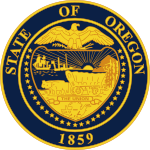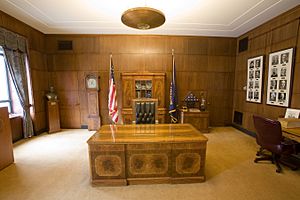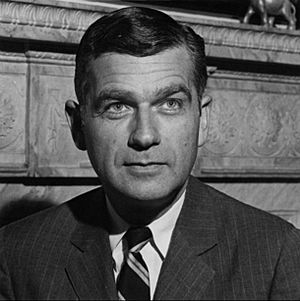Governor of Oregon facts for kids
Quick facts for kids Governor of Oregon |
|
|---|---|

|
|

|
|
| Government of Oregon | |
| Style | The Honorable |
| Residence | Mahonia Hall |
| Term length | Four years, renewable once in a 12-year period |
| Inaugural holder | John Whiteaker |
| Formation | February 14, 1859 (Constitution of Oregon) |
| Succession | Line of succession |
| Salary | $98,600 (2018) |
The governor of Oregon is the top leader of the state of Oregon. Think of them as the "boss" of the state government. They also act as the main commander of Oregon's military forces. The title of governor was also used for the main leader during Oregon's early days, when it was a provisional government and later a U.S. territory.
The current governor of Oregon is Tina Kotek. She started her job on January 9, 2023. In 2018, the governor's salary was $98,600.
Contents
What the Oregon Constitution Says
The Oregon Constitution is like the rulebook for Oregon's government. Article V of this constitution explains how the governor's office works.
Who Can Be Governor?
To be governor, a person must be a U.S. citizen. They also need to be at least 30 years old. Plus, they must have lived in Oregon for at least three years before the election.
There are some rules about who cannot be governor. For example, someone who works for the U.S. government or holds another state office usually cannot be governor at the same time.
A governor can serve for a maximum of eight years within any twelve-year period. This means they can't serve too many years in a row. However, there's no limit on how many total terms a person can serve if they take breaks. John Kitzhaber is the only governor who served terms that were not back-to-back.
How Governors Are Chosen

The Oregon Constitution also explains how governors are elected. It covers how election results are announced. It also explains what happens if there's a tie or a problem with the election.
After an election, the Secretary of State sends the results to the Speaker of the Oregon House of Representatives. The Speaker then shares the results with all the lawmakers in the Oregon Legislative Assembly.
If two candidates get the same number of votes, the lawmakers will vote to decide the winner. If there's a legal challenge to an election, the lawmakers also decide the outcome.
Who Takes Over if the Governor Can't Serve?
Sometimes, a governor might not be able to finish their term. This could be due to illness, resignation, or death. Oregon has a clear list of who takes over next. This list is called the line of succession.
Unlike many states, Oregon does not have a Lieutenant Governor. The current order of who takes over is:
| Position | Current office holder | Political party | ||
|---|---|---|---|---|
| 1 | Secretary of State | Tobias Read | Democratic | |
| 2 | State Treasurer | Elizabeth Steiner | Democratic | |
| 3 | President of the Senate | Rob Wagner | Democratic | |
| 4 | Speaker of the House | Julie Fahey | Democratic | |
When Governors Leave Office Early
Throughout history, some Oregon governors have left office before their term ended. Four governors have died while in office. Five governors have resigned, meaning they chose to leave their job.
- In 1877, La Fayette Grover resigned to become a U.S. Senator. The Secretary of State, Stephen F. Chadwick, took over.
- In 1909, George Chamberlain resigned to become a U.S. Senator. Secretary of State Frank W. Benson became governor.
- In 1910, Benson became ill. He gave his powers to the President of the Senate, Jay Bowerman. Bowerman then became governor when Benson resigned.
- After James Withycombe died in 1919, Secretary of State Ben W. Olcott took over.
- When Isaac L. Patterson died in 1929, President of the Senate A. W. Norblad became governor.
- In 1947, Earl Snell died. The Speaker of the House, John H. Hall, took office.
- In 1952, Douglas McKay resigned to become a U.S. Secretary. President of the Senate Paul L. Patterson became governor.
- After Patterson died in 1956, President of the Senate Elmo Smith took over.
- In 2015, John Kitzhaber resigned. Secretary of State Kate Brown became governor.
Governor's Role with the Military
The governor is the commander-in-chief of the Oregon Military Department. This means they are in charge of Oregon's state military forces. They have the power to call up and send out these forces if needed.
Granting Pardons

The governor has the power to grant pardons. A pardon means forgiving someone for a crime. They can also commute sentences, which means making a punishment less severe. The governor can also return fines or property that was taken. However, they must tell the state lawmakers about every time they use these powers.
For very serious crimes like treason, the governor can only delay a punishment. The state lawmakers then decide if a pardon or other changes should be made.
Governor's Role in Making Laws
The governor can veto laws. This means they can reject a bill passed by the lawmakers. However, if two-thirds of both parts of the legislature agree, they can override the governor's veto. The governor can also reject specific parts of spending bills while approving others. This is called a line item veto.
If needed, the governor can call a special meeting of the lawmakers. They can also call for special elections to fill empty seats in the legislature. If county officials can't fill a vacant seat quickly, the governor can appoint someone temporarily.
Every year, the governor gives a speech called the State of the State address. In this speech, they talk about how Oregon is doing. They also suggest what the government should focus on in the coming year.
Appointing People to State Jobs
If the lawmakers are not meeting, the governor can appoint people to fill state jobs. These appointments last until elections are held or the lawmakers meet again.
Where the Governor Lives
Mahonia Hall in Salem is the official home for the governor of Oregon.
The house was built in 1924. Citizens raised money in 1988 to buy it. It became Oregon's first official governor's mansion. Before Mahonia Hall, the governor would just rent a house, and that house would be called the "Governor's mansion."
Early Oregon Leaders (1843–1849)
Meetings held at a place called Champoeg led to the first rules for the Oregon Country. These meetings also created a temporary government. The first leaders of this government were a group of three elected people. In 1845, the first election for a single chief executive was held. The first person to be called "governor" in Oregon was George Abernethy, who was a well-known businessman.
Timeline of Oregon Governors
| Timeline of Oregon governors |
 |
Images for kids
-
Joseph Lane was a candidate for vice president in 1860.
-
Julius Meier helped start the Meier & Frank department store.
See also
de:Liste der Gouverneure von Oregon sl:Seznam guvernerjev Oregona





